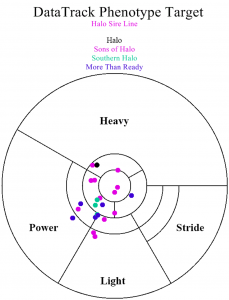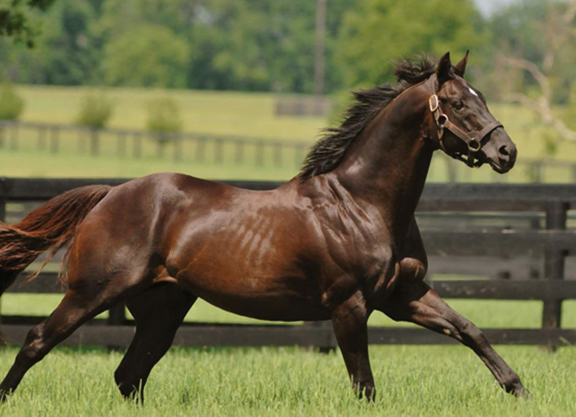By Robert D. Fierro
Sometimes it's staring you right in the face. In this case, it's the fact that there are only two remaining viable branches of the once ubiquitous, and very popular, sire line of Halo. The two branches in question are that of Southern Halo and Sunday Silence.
And this is notable, and important, because? The answer is hidden in the origins, permutations, and travels of each branch since the dawn of the 2000s when each branch assumed its own physical and performance identity while other branches simply faded away.
In this examination, we will concentrate on the Southern Halo branch, specifically through his son More Than Ready, who enters 2018 poised to solidify his always respected, but rarely tumultuous, reputation as a dependable source of speed, acceleration, and quality. We do this because the Sunday Silence branch is still basically rooted in Japan, although it is showing signs of viability in North America and Europe. While pedigree data is abundant, we do not have enough viable biomechanical data to include that branch in this study (although, ironically, More Than Ready's leading earner, the champion mare More Joyous {NZ}, is out of a mare by Sunday Silence).
More Than Ready, on the other hand, has indisputably sealed the deal as the most consistently successful North America- Australia shuttle sire in history-which is far beyond the most optimistic hopes of his connections when he went to stud in 2004.
He has also franked the form of his sire Southern Halo in terms of physical expression and geographical success. We have not found a similar instance of an American-bred sire whose influence as a sire in the Northern and Southern hemispheres includes sons, and grandsons, who are among the leading sires.
Other than as the sire of the elite performer More Than Ready, Southern Halo was not a huge success in Kentucky after an exceptional career in Argentina, but he left several good sons in the Pampas headed now by Sebi Halo.
The focus on More Than Ready comes about because of the serendipitous events of the past two months during which his son Roy H and his daughter Rushing Fall won Breeders' Cup events in November. Meanwhile, More Than Ready's son Catholic Boy became the only 2-year-old to win graded stakes on dirt and turf.
Compounding this news is the fact that More Than Ready's best North American son to date, Verrazano, has his first crop ready to run in 2018, and the sire's best Southern Hemisphere son, Sebring (Aus), is ranked among the top 10 sires in Australia again-and he has been every year since his first crop there turned three.
There are those who look at the pedigree of More Than Ready and wonder where he came from, because his direct female line produced very little quality through four generations despite a build-up of broodmare sires Woodman, Naskra, First Landing, and Better Self. However, the fifth dam was by Blue Larkspur, and her name was Belle of Troy, dam of the excellent racehorse and sire Cohoes. And, of course, Belle of Troy was a daughter of *La Troienne, ancestress of more great racehorses and producers than can fit on the heads of a passel of pins.
With that pedigree behind him, it's not a surprise that More Than Ready was a terrific racehorse succeeding primarily at seven furlongs or less, with a Grade I victory in the King's Bishop S. But many sprinter-leaning types don't succeed as he has, and a study of his record, along with a biomechanical examination of his branch of the Halo line, reveals some interesting clues as to why he has become such a singular success.
He has sired 103 stakes winners in the Northern Hemisphere and 80 in the Southern. The average winning distance of his progeny in the North is 7.08 furlongs, with the average maximum winning distance being 7.44 furlongs. In the South, the corresponding averages are 6.66 and 7.03 furlongs. Thus, he fits right into the breeding and racing schemes of both hemispheres, able to bring speed to the more middle-distance type mares he gets in this country while redoubling the brilliant influences of the mares he gets in the speed-crazy South.
 By reintroducing the Phenotype Target graphic as detailed in our previous column, we can see that one of the reasons More Than Ready (and much of the Southern Halo branch) “fits” successfully has to do with biomechanical properties. In biological terms, a breed carries on best when its male progenitors are closer to the average size and scope of a wide cross section of mares–and can pass those properties on to their descendants. That “average” is expressed in the center of the Phenotype Target.
By reintroducing the Phenotype Target graphic as detailed in our previous column, we can see that one of the reasons More Than Ready (and much of the Southern Halo branch) “fits” successfully has to do with biomechanical properties. In biological terms, a breed carries on best when its male progenitors are closer to the average size and scope of a wide cross section of mares–and can pass those properties on to their descendants. That “average” is expressed in the center of the Phenotype Target.
In general, the Halo line was all over the place in terms of phenotype and aptitudes. Halo himself carried some weight (he would be in the Heavy category) and is probably the single most influential stallion of that type in the past half-century.
However, many of his sons were biomechanical outliers–i.e., they were extremely efficient racing machines but did not have the overall properties to mix with a wide cross-section of mare types and their sons, in turn, became inconsistent progenitors.
Our study of almost 50 Halo-line stallions shows that the Southern Halo branch has more consistently produced stallions that were closer to the average size and scope of the breed, i.e., the bullseye, than any other Halo branch. All of Halo's other sons are in red, but the Southern Halo and More Than Ready sires are in blue and green. For the most part, they are where a majority of successful sires, and sire lines, used to come from back in the day. And as it looks, maybe ahead in the day.
(Bob Fierro is a partner with Jay Kilgore and Frank Mitchell in DataTrack International, biomechanical consultants and developers of BreezeFigs. He can be reached at bbfq@earthlink.net).
Not a subscriber? Click here to sign up for the daily PDF or alerts.






